Graham Reid | | 19 min read
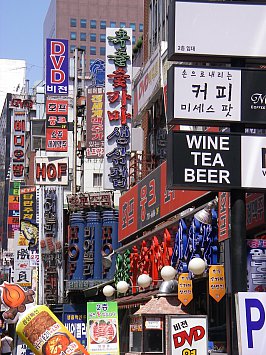
Because I always travel cheap I usually forget that not everyone does. Sure I've stayed in some of the world's most luxurious and most private hotels -- but that's what happens unfortunately when you win travel writing awards sponsored by the Small Luxury Hotels of the World group and they insist on putting you up in their exotic and exclusive digs. (see tag)
But mostly I end up in places where a mosquito coil seems like an extravagence and "mini-bar" means that bottle-shop two doors down below the brothel.
On my trip to Seoul -- I write this from the business centre of the Hyatt Grand where my 12th floor room has a sweeping view of the Hangang (Han River) -- has been a very different experience right from the start.
I have only twice been in that comfy part of the plane behind the pilot -- once because I arrived just as they were closing the door and said "sit anywhere". So I turned left and enjoyed a lazyboy settee for five hours across America. (Good tip folks.)
So as usual at Mangere Airport in Auckland I glanced at my Korean Air ticket (seat 9D) and just waited to be among the last called because they load from the rear. When I got on I realised I was actually among the first beckoned: those who need assistance or have young children, or those who are really really rich (or the company's paying) and ride in comfort.
And there I was (thank you Korean Air) among the latter, just me and some Korean men and their wives who read the business sections of whatever all those papers were. The menu came, the meal deserved to be photographed (I would on the return flight, see below) and I scanned the channels. I clicked on to a Steve Carrell movie -- Dan in Real Life, not much cop -- and the first words I heard were a woman saying, "my perfect day would start with me going to country where people speak a language I don't know . . . ." Or words to that effect.
That is what I love about travel: those strange and sometimes welcome disjunctions, odd coincidences and the unexpected. She could have been speaking for me.
Later I flicked around and saw something alarming on
the news channel about North Korea and nuclear issues, and a major story about
mad cow disease fears in ROK (Republic of Korea, the south where I was headed)
and how infected beef may be being imported from the US. 
Then I saw Will Smith as the sole survivor of some holocaust (mad cow disease? nuclear war?) and living alone in New York. Another strange disjunction.
Seoul of course was far from deserted when I arrived from Incheon in the rain and darkness. People were scurrying into restaurants (why do restaurants in homogeneous Korea advertise themselves as" Korean restaurant"?) and there seemed to be an astonishing number of families with young kids in the Hyatt Hotel when I arrived. Some special offer I was told as happy but well-behaved children ran politely amock in the lobby.
Later I learned I had arrived in a very auspicious time: it was Childrens Day, a few days later Parents Day, and then Buddha's birthday celebrations were starting a various temples around the city.
I love Seoul -- have done since I first came here a decade ago -- and on this, my fourth visit, I have a very full agenda.
This is a high-wired city (I believe over 90% of homes have internet and having your own webpage is a big deal here) and broadband is everywhere. (More on that soon.)
But it is also going somewhere architecturally and has been named the World Design City 2010. I have interviews about that and am asking how Seoul will be challanging Shanghai and Beijing in the region with its innovative urban planning and new architecture.
Seoul is an impressive city (population 10 million and rising) and visitors cannot help but be struck by dozen after dozen, into the hundreds, of 10, 20 and 30-storey apartment blocks that ring and penetrate the city.
They might be unglamorous -- they are, but impressive by number -- but they do provide housing in this country which, just over 50 years ago, was largely in ashes.
Once I came here with some returning New Zealand soldiers who had fought in that forgotten war (the one after World War II and before Vietnam) and many had tears in their eyes when they saw the arcs of motorways and the highrise development. They remembered the country as shell-blasted and with nothing over a single storey standing. Barely a stick standing around here half a century ago.
South Korea's achievements (and yes, they have come at some social costs and political suppression for a long time) are impressive. I'm glad to be here asking questions and listening.
I am ready for the task, I pushed one zero too many at the ATM at the airport and now have 1,000,000 won in my possession (about $NZ1300 I think) but I don't intend to spend it all in the same shop.
And I do have to shop. A priority today before I go to various museums, the art gallery down the hill and to see some architecture, is to buy a couple of snappy shirts.
In my haste to pack notebooks, camera, itinerary and such I left my neatly pressed dress shirts (thank you darling) hanging on the bedroom door.
So I am off to get something to impress the mayor.
Real news will follow regularly. Meantime here I am, loaded with the folding and ready to step out into a warm clear spring day in Seoul, capital of the "Land of Morning Calm".
SEOUL SEARCHING
With a good Metro system and useful street signage (aside from not naming streets), Seoul is an easy city to get your way around in -- but more fun when you get lost.
That's easy to do too, just come out of a Metro on the wrong exit and walk a few metres the wrong way and you are suddenly disorientated and happily lost.
But then another Seoul becomes evident.
As with many Asian cities -- I'm thinking of Tokyo -- Seoul is made up of small districts, 21st century villages if you will, which retain almost ancient characteristics.
And So although Seoul boasts high rise, public sculpture (nice Oldenburg, see left), the newly developed river walk (which might look faux but does follow the old stream, cost squillions and offers an area of quiet -- except for the families and kids -- and all the other trappings of a modern city, you also find street stalls selling various kinds of food from broth to squid kebabs, women on the footpath telling fortunes, and old men selling those shapeless beige clothes that so many women over 50 seem to take pride in here.
These villages -- which have local restaurants and bars, parks where old men play board games and the visible homeless sleep under the trees, and various churches, temples, 7-11 stores, veggie shops and sellers of dried fish -- are scattered throughout central Seoul just down alleys or sidestreets away from the more well walked streets.
The fact these local areas thrive in the face of development gives Seoul a . . . well, you know how that has to end.
Much of this interesting stuff exists at ground level and is quite visible. In fact around one of the bigger Buddhist temples I was tripping over Buddha-detritus and people hawking cheap trinkets to the faithful.
But Seoul also goes up and down: bars, bookshops, cinemas, hair salons and so on can be five flights up or two floors down. That makes this city a constant discovery -- and for me rediscovery.
I'm stayin near Itaewon (a very touristy area currently undergoing a makeover) but got as far away as quickly as possible, and the Metro was very helpful in that.
I saw a wonderful exhibition of paper art in a gallery inside one of the stations, took photographs of lots of interesting buildings (ancient and modern), walked for hours, ate, shopped, got sort of lost a few times, saw worrying things (I guess we'll get Internet Dating: The Musical in due course) and thoroughly enjoyed a long day.
Right now Seoul is full of the joys of spring: kids, blossoms, balloons, face-painting, bands playing, lanes so crowded your walk is reduced to a slow shuffle . . .
The weather is mild, the sky cloudless and the mounatins which are suprisingly close and visible from many of the wide roads in the city centre are a gorgeous pale blue.
I have bought my replacement shirts and some K-pop and hip-hop CDs, the mango icecream was delicious, and the baseball cap necessary to keep the sun off my nose which, of course, feels even more noticeable in this environment.
As does the height, the beard, the hair and the clumsy pointing to things and stuttering something entirely wrong in a language which sounds like a threat of serious violence when shouted but seduces like rippling water when whispered.
My meetings start in earnest after my time of reorientation and given Seoul is going to undertake some major redevelopment I guess my job is to ask how much of what I love about this place, those little alleys into villages thriving in an urban environment, are going to survive.
I better get dressed up for my busy programme (which
actually has "rest" written at 22.00 hours). I
can't wait.
I've even got my shirt picked out.
HISTORIC PRESENT, PRESENT TENSE AND FUTURE PERFECT
Okay, here's what's going to happen -- and we leave aside the ifs, buts and maybes for the moment, of which there are a few. But the future of Seoul will be like this: a modern city which will look like bits of Dubai (with greenery) will rise alongside the Hangang River and it will be fed by digital services, incorporate retail and residential, be a business hub for Asia and of course be eco-friendly.
It will, in short, be as perfect a vision of the future as you can imagine -- outside of that old movie The Shape of Things To Come.
Frankly, on paper and in the slideshow presentation I was treated to yesterday, I was hugely impressed. It does of course have a name: Dreamhub -- and doesn't that just make your pulse pound?
It will tranform Seoul -- the presentation was full of slogans such as "A Clean and Attractive Global City" and "The Hangang Renaissance" -- and the assembled journallists were told it would change Seoul from "a Hard City into a Soft City".
In slides which showed Rome and London as the hubs of their empires, Seoul was presented as being prepared to become the centre of the world and Dreamhub will be its heart.
I have been to such presentations before and hyperbole and hi-tech data-show presentations are common: but there is something about the Korean capacity for work (they are the hardest working people on the planet) and their relentless drive for progress that makes me think that at least some of this will happen. (In fact some of it already is.)
They don't have much time however and have set
themselves 2020 to get the job done (not to mention the overhaul of various
other parts of the city, the creation of satellite cities and so on). But I
think they will get on with the job. Of course
the whole thing is fraught with economic uncertainty, what happens when civic
leaders change and so forth.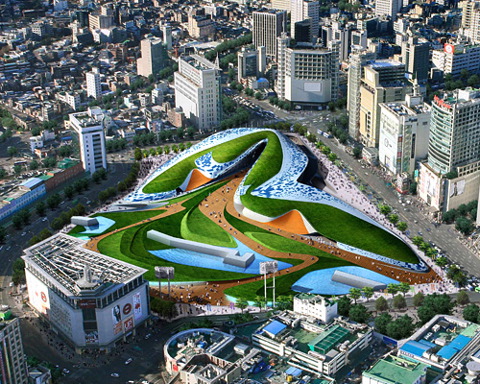 There was very little question time -- we were all too stunned by
the images of landmark towers and so on -- but among them will be what happens to the current inhabitants of those
areas, how can this be steered through consecutive metropolitan governments over
the next decade, what happens if the economic bubble bursts (as it has in the
past), and . . .
There was very little question time -- we were all too stunned by
the images of landmark towers and so on -- but among them will be what happens to the current inhabitants of those
areas, how can this be steered through consecutive metropolitan governments over
the next decade, what happens if the economic bubble bursts (as it has in the
past), and . . .
Okay, here is what Seoul has going in its favour to realise the planners' dream: the average age is 36.7, this is a plugged-in society (an average of 1.4 computers per home, 91.8% internet penetration), digital and design businesses are cornerstones of the country's growth and are having government and private investment poured into them; Korea has the 7th fastest economic growth rate in the world, and Seoul itself (population 10 million, 24 million in the greater Seoul area) has only one mayor and three vice-mayors.
It has the infrastructure, the will, a streamlined development and planning process -- and it has slogans to inspire: "Centre for the Future, the Centre of the World" and "We Will Realise These Goals".
Of course progress comes at a price and some are rightly concerned that the special nature of this vibrant city -- which I alluded to previously -- will be lost and buildings of character will be torn down (that is happening already).
But you have to admit Zaha Hadid's vision for
Dongdaemun Stadium (above) is stunning.
And
hers is just one development project among dozens.
After that high-powered briefing it was a delight to go to the home of the Zen master Soo Bool Sunim for an hour of typically bewildering discussion and questions ("Can you see your own eyes?")
His home is sort of emblematic of so much of this city and its odd juxtapositions. He lives in a suburban street and across the road is a low-rise of brick apartments. Above the traditional roofline of his home you can see the cross from the Presbyterian church just up the road. Step out from his quiet garden and rooms and you are in the world of hip restaurants, wine shops, art galleries and cafes.
I guess none of that collision of life styles, cultures and attitudes will exist in the new supercity areas of Seoul?
The master spoke in those questions and riddles that tickle the mind, and one thing he said really struck home. I asked if there was such a thing as change, or is everything changeless.
Through the translator there was a convulted answer which was peppered with other questions and I think maybe even a mild rebuke, although his shining and beaming demeanour would deny that.
The translator said, "do not be held captive by words".
The master smiled.
I asked the translator later if he would pass on something to the master from me, that those words in particular struck me as important but also very funny: "I am a journalist".
He told the master, and the master's gentle expression of benign good humour didn't change.
It may be the only thing I've seen in Seoul which struck me as permanent.
(During a walk along the river development I also met Robert Koehler, an American who has been a longtime resident of Korea, these past five or so years in Seoul. He writes the best blog about contemporary Korea and like me shares a love of architecture. Check him out here http://www.rjkoehler.com/.)
ENCOUNTER WITH A MASTER MUSICIAN
So did I mention that right next to the Ahnkook Zen Centre in Seoul is the Seoul Museum of Chicken Art? Or that at the performance of The Princess Who Fell in Love With B-Boy (a cross-genre dance production with pounding hip-hop which is going to Broadway in October) that there were four middle-aged monks behind me in the audience of screaming girls and air-punching young men?
Or that to get to the home of Professor Hwang -- the master of the gayageum and who perhaps single-handedly preserved the traditional music of Korea and has been taking it to the world -- you walk up typically narrow and unglamourous streets and alleys.
Of course once inside his house you get a spectacular view over the low and high-rise buiildings of the city, and his upstairs lounge which is a clutter of papers, shopping baskets of CDs, instruments and documents feels quite remote from the noise and tawdry chaos outside.
Hwang Byungki is an extraordinary man: when he first started learning the gayageum (like a zither) in the early 50s his country was recovering from the Japanese colonial era, the Second World War and the invasion of North Korea and China down the peninsula.
There was very little information about either traditional court music or folk music (none or very little of which was written down) and many of its practitioners had passed on.
"When I began to learn gayageum in 1950," he said, "only about a dozen new gayageum were being sold each year. Now there are 10,000 a year."
For which the quiet, composed professor should take credit.
Now there are well-established music departments teaching traditional music and the sound of the gayageum is so popular that there has emerged the inevitable fusion movement where the instrument is found in the context of synthesisers, drums and electric guitars.
The man who has rarely incorporated Western classical instrumentation with gayageum passes lightly over what he thinks of that.
What he does say -- and he also said how much he enjoyed being in New Zealand for a concert some years ago -- is that Korean music is the least known music from the Orient in the Western world.
That is because the music of Indonesia, Japan, India, Vietnam and so on filtered back to the West through the colonial powers. Korea's colonial power was Japan and so the music remains, and to a great extent still remans, in the East.
To meet this man was one of the highlights of this visit to Seoul and when I asked for an interview with him -- like a Korean journalist going to Wellington and asking if they could pop around for a chinwag with Peter Jackson -- I never expected to meet him.
And yet . . . .
That's pretty much what is happening here: doors are opening, tea is drunk, many hours are spent cross-legged and there is the usual hurry-up and wait. I have also stumbled on things by pure chance, notaby great art galleries such as this: ttp://www.arariogallery.co.kr/exhibition/exhibition_past_artwork.php?exhibition_serial=49
Much of what I am picking up will of course make its way at greater length and with more consideration into other media outlets in NZ and abroad, and today I have a meeting with someone who is going to talk about the digital art movements here which I have encountered at the Venice Biennale and elsewhere. If there is one thing Korean artists, and the people in general, are comfortable with it is technology. They use it in every aspect of their lives from social networking to reaching out into the world via the arts.
Today there is also a meeting at our High Commission which I have requested -- and much more before dinner with the mayor of Seoul. That's why I packed the jacket.
Righto, off to encounter yet another cultural collision which I will not only survive but be delighted and informed by.
MY BRILLIANT KOREA
And so the final days in Seoul went by in a blur: astonishing digital art and exciting galleries; interviews with an art critic, a digital artist, a musician and a food writer; dinner with the mayor and a meeting with our genuinely nice people in our embassy; the helpful and friendly company of good natured interpreters and hosts; more talk about designers and architects turning Seoul into the hub of Asia, walks through historic areas and hip streets, terrific food, buying CDs and DVDs . . .
And most interest perhaps, I went to OhMyNews, the online newspaper, and spoke with senior editor Todd Thacker and communications director Jean K. Min. (see tag)
Founded eight years ago, OhMyNews has citizen journalism at its core, now works out of the 18th floor of the impressive Nuritkum Business Tower in Mapo-gu about 40 minutes by taxi from central Seoul (right), and has a code of ethics which all citizen journalists must agree to and sign.
OMN employs about 90 people in its office (stories are subbed and fact-checked which is more than you can say for some mainstream print media these days), and it has its own television studio.
OMN also opened its own journalism school in November '07 in Incheon where aspiring online journalists of all ages/persuasions and backgrounds can go for intensive classes in ethics, writing, media literacy, digital technology and so on.
In many ways, although it is cutting-edge in terms of its online focus, there is much which is traditional and familiar about the way OMN operates. But of course it is very different too: copy is created fast and published with an immediacy, it is liberal and opinionated, relies on citizens in the frontline rather than media outlets far away, and has a compelling personality to it.
It is one way into the future of new media convergence -- and has been there for eight years.
This isn't blogging made big, rather old media reconfigured to take advantage of the new and divergent media possibilities.
Coincidentally across town -- and literally in every part of town -- on the day that I was talking to Min, bloggers were at work on the issue of beef from the US and whether it was infected by "mad cow disease".
In the absence of supporting science, bloggers started posting dire warnings, horror pictures of crazed cows and people possibly infected, and nightmare scenarios of mass poisoning. In blog-connected Korea where many tens of thousands of citizens have their own websites and people blog like you and I buy coffee, the fear took flight.
Two nights later more than 10,000 (mostly young) people gathered to protest in the centre of the city -- and OMN was there with portable digital cameras doing interviews.
The beef issue became a lightning rod for all kinds of disapproval about President Lee Myung-bak: over 1.2 million people signed an on-line petition to impeach him and his approval rating was the lowest of any president -- down to Bush-like levels. Opposition parties circled, national pride was at stake, teachers and students weighed in and joined the protest, and prosecutors said they were investigating whether legal action could be taken against those who spread false rumours and fears online.
But rumours spread even more widely -- and some started suggesting Lee had given the disputed Dokdo Islands in the East Sea to Japan. Within days 20,000 people had signed an online petition about that.
As with the mad cow caper, there was very little evidence (none in the latter case actually) to suggest this was the case -- but the blogosphere went ballistic. It was like the "Paul is Dead" rumour for those old enough to remember that one: people were scouring for clues and -- sure enough -- finding them.
Interesting. Especially when you consider that in the mainstream media a more interesting and potential much more dangerous story was being broken: that Seoul's first case of bird flu had been identified in two dead pheasants in an aviary near the country's largest open market in Seongnam outside Seoul.
Infected ducks had infected the pheasants, officials had hastily closed the poultry section. (A longtime expat resident said, "what with the beef and the birds, dog is starting look like the best option".)
You can make what you will out of this about blogging's power to perhaps mislead or create mischief as much as broker important issues.
A psychology professor at Seoul's Yonsei University told the JoongAng Daily, the reasons for the online panic which translated into major protest action was partly cultural in this highly wired and interconnected country: "Koreans have a tendency to put more importance on what others think and say than developing their own thoughts and voice. It is because the authority infrastructure has collapsed and lost credibility among the general public."
Well, that's a long discussion about cultural and social mores, how Korea developed as a country over centuries and what happened to it in the last half of the 20th century, and why Koreans are so enthusiastic about the online world.
A professor in politics told the same paper, "the younger generation tends to think of the Internet as a playground that is distant from reality."
The thing about OhMyNews is that it sees these areas as acutely interconnected, which is why it has an inbuilt series of checks and balances (just like some old-time media) and its voice on bird flu was more measured (although still allowing that there was more to this than bland assurances coming from various officials).
It was an interesting time to be in Seoul -- but then again that is always true. It is a wonderful place where odd juxtapositions of the old and new constantly assail you (right). It is a fascinating city which is going to be a great one. If the economic bubble doesn't burst.
It is a city in a country full of ambition and a work ethic. It also has vibrant arts, hot music of all kinds (some of which I bought to post at Music From Elsewhere), friendly people, an abrasive edge, arcane politics and history, strong liquor . . .
On reflection, my previous three visits to Seoul had all been one-dimensional in their own ways. But on this trip -- thanks to Seoul Selection who put me in touch with many and various people, and provided an excellent interpreter -- took me to places I wouldn't normally see and opened doors which would otherwise have remained closed, I saw and felt a lot more about this vibrant and diverse city.
In my final days I went to the Seoul Selelction bookshop and went slightly mad buying English-language books on Korean design and architrecture, history and film, plus some CDs and DVDs that had been recommended to me by various people, Robert Koehler included (see above).The Seoul Selection Bookshop (which includes Hank's Cafe -- try the teas) posts internationally and has a good online site.
On my final morning I took the Metro out to see the magnificent new W Hotel at Walkerhill and spent an hour just photographing the exceptional exterior and the stylish lobby with its long bar, spacious and tiered seating area and DJ console inside an egg-shaped booth.The view across the Hangang River from this point halfway up a mountain is also spectacular. Check it out here:
http://www.starwoodhotels.com/whotels/property/overview/index.html?propertyID=1451
Then I went back to Insa-dong and to a funky museum of oddball toys, old games consoles, movie posters, record players and radios, bottles, kitsch, trivcia and rubbish. It cost only 1000 won to enter and everyone in the crowded place was happily snapping away photographs of the stuff which was piled high everywhere. I don't know Korean for "my mother used to have one like that" but I think a lot of people were saying it. It was hilarious.
Down the road I bought some gifts and watched yet another street parade, and then in the late afternoon went to the airport.
As the plane lifted off, for the first time I had the opportunity to reflect on how much I had seen and learned.
"A lot" was the simple answer, and also not
enough -- which always provides you with the perfect excuse to go
back.
I want to see how the redevelopment of Seoul comes into effect, if they can manage to built the new without sacrificing the old (for those developments I will stay tuned to Robert's site here: http://www.rjkoehler.com/ )
On the flight home I also started to sketch out stories that I could write out of these five intense days: something about OhMyNews; articles of design and digital art; a profile of the great Byungki Hwang for an American magazine and playing his music on New Zealand's Concert Programme; some articles about the redevelopment of Seoul and the "Dreamhub" . . .
There was going to be much to do, and those were just the pieces that occured to me within 10 minutes of take-off.
Korea had got under my skin again and all I wanted was for the plane to turn around and drop me back in to that fascinating place.
Then dinner arrived and damned if the herbs on the salmon didn't look like hangul lettering to me.
If I could just figure out what it was trying to tell me . . .
Postscript: I think this is funny. A few days later back in Auckland I went into my Westpac on Queen St to try and change a hundred thousand or so Korean won into Kiwi money -- and they said they couldn't do it. I went to the National Bank down the road and they could, but it would cost me $5. Fair enough. Then the young woman came back and said actually it would cost $12 because the won was an "exotic currency" and not one they usually dealt with. I joked that Korea was our seventh largest trading partner (our PM is there this week) and noted to myself they had six exchange rates posted, including Canada. While she went off for 10 minutes to do the paperwork (I got $112 back) I looked at the signage.
Upstairs in this place where my left-over won was considered an "exotic currency" they had a whole Korean Banking Division.
For information on Seoul Selection: http://www.seoulselection.com/what_is_seoulselection.html
Or: http://www.seoulselection.com/contact_us.html
This is an edited and expanded version of a series of blogs written for publicaddress.net while in Seoul between May 5 - 10, 2008 where I was a guest of the Seoul Metropolitan Government and Seoul Selection. I flew Korea Air (my kinda airline).


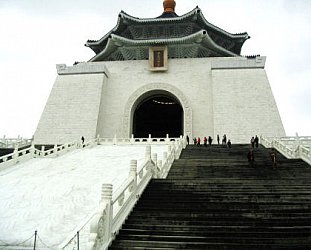

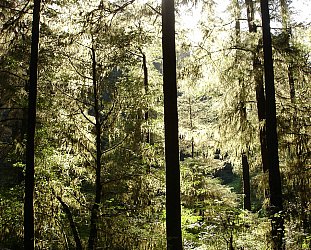
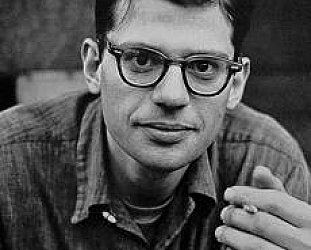
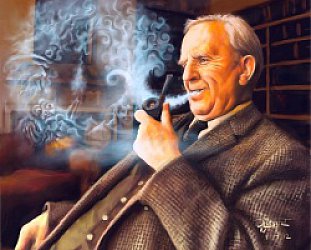
post a comment